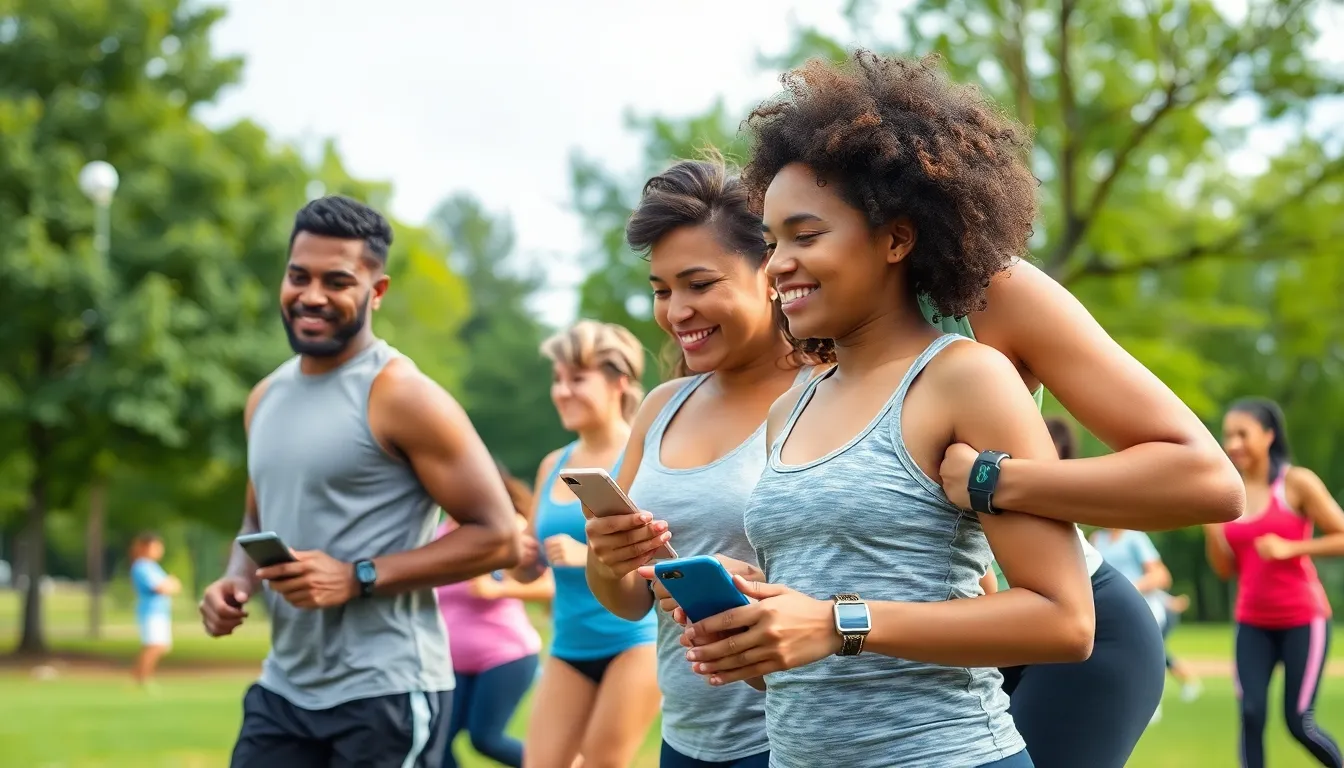In a world where the couch often calls louder than the gym, it’s time to answer with a little help from technology. Enter the realm of fitness apps—those delightful digital companions that not only track steps but also turn workouts into a game. Who knew sweating could be so much fun? With a few taps on a screen, anyone can transform from a couch potato into a fitness enthusiast, or at least a slightly more active potato.
These apps don’t just count calories; they motivate, challenge, and sometimes even make users laugh out loud while they’re huffing and puffing. From step challenges that rival a friendly competition to guided workouts that feel like having a personal trainer in your pocket, there’s something for everyone. So why not ditch the excuses and grab your smartphone? It’s time to get moving and discover how these apps can make physical activity not just beneficial but downright enjoyable.
Table of Contents
ToggleOverview of Apps That Promote Physical Activity
Fitness apps play a crucial role in encouraging physical activity. Many of these applications track various metrics, including steps, calories burned, and distance traveled. By providing real-time feedback, users can monitor their progress effectively and stay motivated.
Gamification elements enhance user engagement, transforming workouts into exciting challenges. For instance, step challenges motivate individuals to surpass their previous records, fostering a competitive spirit. Users often find enjoyment in completing daily goals and earning rewards, which makes exercising feel less like a chore.
Guided workouts offered by these apps provide structured routines tailored to various fitness levels. They accommodate beginners and advanced athletes alike, ensuring everyone can find suitable fitness plans. Instructional videos and audio cues often accompany these workouts, offering users the guidance they need to perform exercises correctly and safely.
Community features also contribute to increased motivation. Users can connect with others, share achievements, and participate in group challenges. Social interaction adds a layer of accountability, promoting a supportive environment where individuals encourage one another.
Customization options further elevate user experience, allowing individuals to set personal goals that align with their fitness journey. These apps often provide analyses of past performances, helping users adjust their strategies for continued improvement.
Fitness apps advocate for a more active lifestyle, utilizing technology to engage users in their physical activities. They transform sedentary routines into dynamic experiences, proving effective in promoting consistent exercise habits.
Types of Apps Available

Various types of apps enhance physical activity through unique features. Each app category supports different user needs, encouraging a more active lifestyle.
Fitness Tracking Apps
Fitness tracking apps focus on monitoring physical activity metrics. They allow users to log steps taken, calories burned, and distance traveled. Real-time data helps individuals recognize their progress. Integration with wearable devices enhances accuracy. Users benefit from goal-setting features, pushing them to achieve personal milestones. Encouragement from reminders fosters consistency. Popular options include MyFitnessPal and Fitbit, known for their comprehensive tracking capabilities.
Workout Guide Apps
Workout guide apps provide structured exercise routines. These apps feature instructional videos and step-by-step guidance for various fitness levels. Accessibility to diverse workouts caters to everyone, from beginners to advanced athletes. Users receive tailored recommendations based on personal goals and preferences. Visual aids simplify the execution of exercises, ensuring proper form and technique. Noteworthy examples include Nike Training Club and JEFIT, which emphasize guided fitness experiences.
Activity Challenge Apps
Activity challenge apps promote friendly competition among users. They engage individuals by offering step challenges and fitness contests. Users can participate in community-driven events, enhancing motivation through social interaction. Many apps allow individuals to create challenges for personal goals. Gamification elements encourage adherence and drive users to outperform previous achievements. Popular choices include Strava and StepBet, focusing on community and goal achievement.
Benefits of Using These Apps
Fitness apps provide significant advantages that enhance users’ physical activity and overall health. They motivate individuals and create a sense of accountability within their fitness journeys.
Motivation and Accountability
Fitness apps effectively boost motivation through various features. Users often engage with friends and community members, fostering a competitive environment. By setting daily goals, individuals track their progress and celebrate achievements. Gamification elements, like badges and rewards, create incentives for consistent activity. Sharing milestones generates social encouragement, which helps maintain accountability. Regular notifications and reminders also keep users on track, making it easier to prioritize workouts.
Personalized Fitness Plans
Many fitness apps offer tailored workout plans to meet individual needs. Users can input personal goals, preferences, and fitness levels. Customized routines adapt over time based on performance, ensuring continuous progress. Access to instructional videos allows users to practice exercises with proper form. Additionally, these plans often include nutrition guidelines for holistic health. Adjustments become intuitive, keeping individuals engaged while they strive for their health objectives. Integrating user feedback enables the development of even more effective plans that suit diverse lifestyles.
Popular Apps on the Market
Various fitness apps provide tools that encourage physical activity. Each app features unique capabilities that cater to diverse user needs and preferences.
App 1: Features and Benefits
MyFitnessPal excels in tracking calorie intake and physical activity metrics. Users input food and exercises to monitor progress and reach nutritional goals. This app integrates with various wearable devices for improved accuracy. Achievements may be celebrated with badges for milestones, adding motivation. Community forums connect individuals, fostering support and accountability through shared experiences. Accessibility on both mobile and desktop makes it easy for users to manage their health wherever they are.
App 2: Features and Benefits
Nike Training Club offers an extensive library of guided workouts. Users can choose routines tailored to their fitness level and goals, including strength and cardio sessions. Instructional videos ensure proper form and technique, making it user-friendly. The app includes customizable training plans that adapt to users’ progress and preferences. Integration with social features allows users to challenge friends and stay accountable. Additionally, regular updates introduce new workouts, keeping engagement high.
App 3: Features and Benefits
Strava focuses on outdoor activities like running and cycling. Users track performance metrics such as distance, speed, and elevation gain. The platform enhances community engagement through leaderboards and challenges, motivating participation. Users can join clubs and interact with others, sharing achievements and routes. Customizable goal-setting options also exist, enabling users to target specific performance improvements. Integration with various GPS devices ensures accurate tracking during activities.
Tips for Choosing the Right App
Selecting the right fitness app requires considering various factors. Assess personal fitness goals first; some people prioritize weight loss, while others aim for muscle gain or endurance. Evaluate app features next; look for options like personalized workouts, tracking metrics, and community interaction.
Examine user reviews and ratings to gauge effectiveness. High ratings often indicate reliable performance and user satisfaction. Identify compatibility with devices, as some apps integrate better with specific wearables.
Consider the app’s user interface; an intuitive design enhances usability, making workouts enjoyable. Explore customization options, as these allow users to tailor the app experience to their preferences.
Investigate cost structures of fitness apps. Many offer free trials but charge for premium features. Analyze the availability of instructional content; accessible videos and tutorials help users maintain correct form and prevent injuries.
Check the level of community engagement within the app. Active communities provide motivation through challenges, support, and shared achievements. Prioritize apps that update content regularly to keep workouts fresh and engaging.
Lastly, keep security in mind, especially regarding personal data. Trusted apps should comply with privacy regulations and protect user information efficiently. By examining these aspects, individuals can select an app that aligns with their fitness journey and encourages a more active lifestyle.
Fitness apps have become essential tools for anyone looking to enhance their physical activity levels. By combining tracking capabilities with gamification and community support, these apps create a motivating environment for users. They not only help individuals monitor their progress but also make exercising enjoyable through challenges and guided workouts.
As technology continues to evolve, the potential for fitness apps to inspire healthier lifestyles grows. With various options available, users can find the right app that aligns with their personal fitness goals. Embracing these digital resources can lead to lasting changes in habits and overall well-being, making physical activity a more integral part of daily life.








